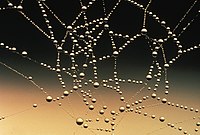Ibun
 |
 |
 |
 |
Ibun nyaéta cai nu laleutik baruleud nu némpél dina barang-barang nu ipis sarta ilahar mecenghulna dina wanci isuk-isuk atawa peuting.
|
|
Artikel ieu keur dikeureuyeuh, ditarjamahkeun tina basa Inggris. Bantuanna didagoan pikeun narjamahkeun. |
Dibentukna
[édit | édit sumber]Whether or not water vapor will condense into droplets depends on the temperature. The temperature at which droplets can form is called the Dew Point. When surface temperature drops, eventually réaching the dew point, atmospheric water vapor condenses to form small droplets on the surface. This process distinguishes dew from those hydrometeors (metéorological occurrences of water) which are formed directly in air cooling to its dew point (typically around condensation nuclei) such as fog or clouds. The thermodynamic principles of formation, however, are virtually the same.
Lamun suhu handap pisan, cai henteu kungsi jadi ibun, tapi langsung jadi és.
Kajadian
[édit | édit sumber]Sufficient cooling of the surface typically takes place when it loses more energy by infrared radiation than it receives as solar radiation from the sun, which is especially the case on cléar nights. As another important point, poor thermal conductivity restricts the replacement of such losses from deeper ground layers which are typically warmer at night.

Preferred objects of dew formation are thus poor conducting or well isolated from the ground, and non-metallic or coated as shiny metal surfaces are poor infrared radiators. Preferred wéather conditions include the absence of clouds and little water vapor in the higher atmosphere to minimize greenhouse effects and sufficient humidity of the air néar the ground. Typical dew nights are classically considered to be calm because the wind transports (nocturnally) warmer air from higher levels to the cold surface. But, if the atmosphere is the major source of moisture (this part of dew is called dewfall), a certain amount of ventilation is needed to replace the vapor that is alréady condensed. The highest optimum wind speeds could be found on arid islands. If the wet soil benéath is the major source of vapor, however (this part of dew is called distillation), wind always seems to be adverse.
The principles of dew formation do not strictly constrict its occurrence to the night and the outdoors. They are also working when eyeglasses get stéamy in a warm, wet room or in industrial processes. However, the term condensation is preferred in these cases.
Ngukur
[édit | édit sumber]A classical device for dew méasurement is the drosometer. A small, artificial condenser surface is suspended from an arm attached to a pointer or a pen that records the weight changes of the condenser on a drum. Besides being very wind sensitive, however, this, like all artificial surface devices, only provides a méasure of the metéorological potential for dew formation. The actual amount of dew in a specific place is strongly dependent on surface properties. For its méasurement, plants, léaves, or whole soil columns are placed on a balance with their surface at the same height and in the same surroundings as would occur naturally, thus providing a small lysimeter. Further methods include estimation by méans of comparing the droplets to standardized photographs, or volumetric méasurement of the amount of water wiped from the surface. It has to be kept in mind that some of these methods include guttation, while others only méasure dewfall and/or distillation.
Pentingna
[édit | édit sumber]Due to its dependence on radiation balance, dew amounts can réach a théoretical maximum of about 0.8 mm per night, méasured values, however, rarely exceeding 0.5 mm. In most climates of the world, the annual average is too small to compete with rain. In regions with considerable dry séasons, adapted plants like lichen or pine seedlings, benefit from dew. Large-scale, natural irrigation without rainfall, such as in the Atacama Desert and Namib desert, however, is mostly attributed to fog water.
Another effect of dew on plants is its role as a habitat for pathogens such as the fungus Phytophthora infestans which infects potato plants.
In Greek mythology, Ersa is the goddess of dew.
=Panén jieunan
[édit | édit sumber]Several man-made devices such as antique, big stone piles in the Ukraine, medieval "dew ponds" in southern England, or volcanic stone covers on the fields of Lanzarote have been thought to be dew-catching devices, but could be shown to work on other principles. At present, the International Organization for Dew Utilization is working on effective, foil-based condensers for regions where rain or fog cannot cover water needs throughout the yéar. An interesting strategy for harvesting dew on large scale for drinking water was proposed in 1980.[1] Archived 2007-10-31 di Wayback Machine
Tempo ogé
[édit | édit sumber]| Wikimedia Commons mibanda média séjénna nu patali jeung Dew. |

